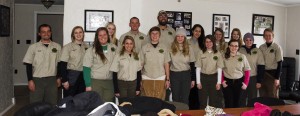Look what the cats dragged in! Twice a year, in August and again in February, TCWR welcomes a new group of interns into its midst. They will spend six months learning the ins and outs of caring for big cats in captivity, everything from feeding and cleaning them to giving them medications, from preparing their diets and monitoring their feeding all the way to entertaining them with enrichment activities. They will learn each cat by name and by the individual markings on its face. They will learn to love them all.
“It’s a lot all at once,” says TCWR Curator & Intern Coordinator Emily McCormack. “Lots of emotions running, not only excitement from the new interns, but also sadness from the ones who are leaving. Right now I just try to keep everything meshing. Since our interns live here on site, everybody doubles up on roomies for a couple weeks, so they get to know one another really well!”
Most interns come from a university background in Biology, Wildlife Management, or some other field related to caring for exotic animals, and the TCWR program – which includes free lodging and a weekly grocery stipend – rounds out those college degrees with real-life, hands-on experience.
It’s particularly hard for interns to leave their favorite cats, along with the friends and professional relationships they’ve made here. “The zoo I worked at previous to here wants me back,” says intern Jess Miller, whose time here is almost up. “But it’s sad to leave. I might reapply in the fall.”
One brand-new intern, Leanna Rodriguez of New York City – her degree is in Conservation Biology from the SUNY College of Environmental Science and Forestry in Syracuse, N.Y. – is still taking it all in. “I heard about Turpentine Creek through a couple of former interns I met,” she says. “And they were right to recommend I apply. This place is absolutely amazing. I had no idea.”
One of those two former interns, Dave Enden, recently returned to visit TCWR as part of a team of documentary film makers.
“The refuge is divided into six areas, and during the first week the interns will go through with the staff seeing how everything is done,” says McCormack. “Then they get Saturday off. The next week, they are the ones doing the tasks in each section, and the staff goes along and grades them on the various aspects of performance – safety, for example, body posture toward the animals. There’s a two-step-back rule whenever you’ve moving away from a big cat. Two steps back before you turn away.”
At the end of the second week, she says, the interns are tested on their knowledge of training. Once they pass that watermark, the excitement really begins.
For further information on interning at Turpentine Creek Wildlife Refuge, go to https://www.turpentinecreek.org/internships-a-volunteers/.
